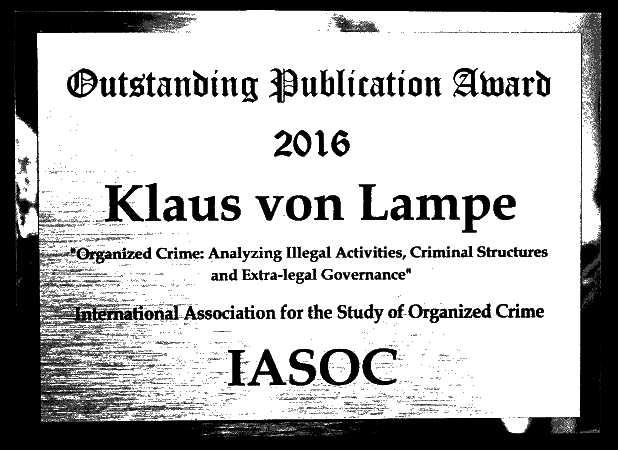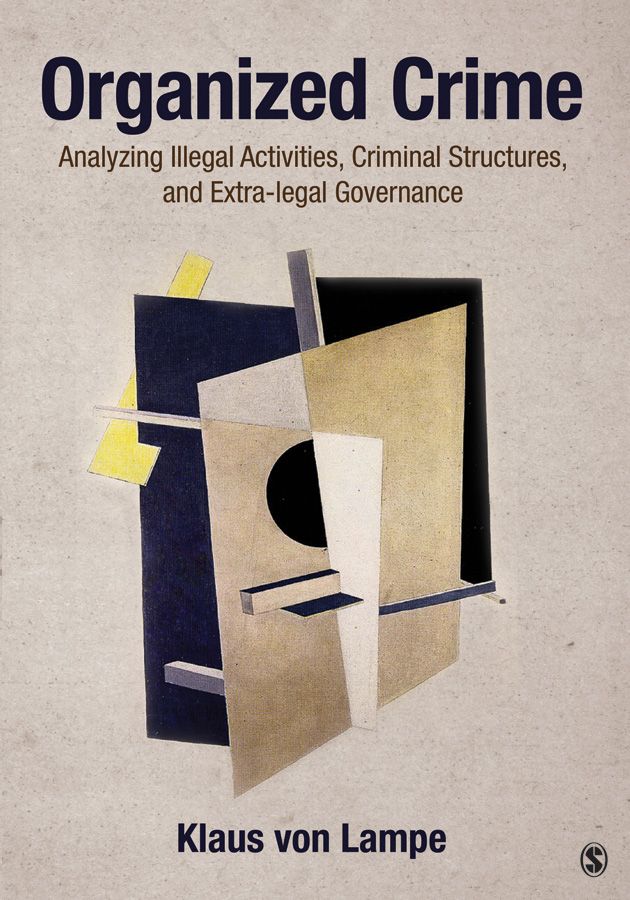
Klaus von Lampe
Organized Crime: Analyzing Illegal Activities, Criminal Structures, and Extra-legal Governance
Thousand Oaks, CA: Sage, 2016
488 p.
ISBN 978-1-4522-0350-8
 2016 Outstanding Publication Award (IASOC)
2016 Outstanding Publication Award (IASOC)
“a major contribution to the literature”
"a really impressive book"
"very interesting, thorough, and up-to-date review of the literature on organized crime"
“by far the most comprehensive and thoughtful treatment of the subject matter”
"most definitely the ultimate textbook on organized crime"
“the most compelling composite of this social and economic phenomenon known as organized crime"
"provides a conceptual framework for the future study of organized crime"
“accessible and detailed ... a kind of hybrid textbook-monograph ... highly recommended”







Table of Contents:
Part I: Organized Crime as a Construct and as an Object of Study
Chapter 1: Introduction - The Study of Organized Crime
Phenomena Associated With Organized Crime
Conceptual Confusion
What Is the Object of Study in the Study of Organized Crime?
Chapter 2: The Concept of Organized Crime
The Conceptual History of Organized Crime
The Reception of the American Concept of Organized Crime in Other Countries
Lessons to Be Learned From the Conceptual History of Organized Crime
Overview of Definitions of Organized Crime
Outline of a Conceptual Framework for the Study of Organized Crime
The Concept of Organized Crime: Summary and Conclusion
Chapter 3: Organized Crime Research
The Study of Organized Crime as an Academic Subdiscipline
The History of the Study of Organized Crime
The Main Lines of Contemporary Research
Challenges to the Study of Organized Crime
Research on Organized Crime: Summary and Conclusion
PART II: Empirical Manifestations of Organized Crime
Introduction to Part II
Chapter 4: Organized Criminal Activities
Why Study Organized Criminal Activities Separate From Criminal Organizations?
Outline of This Chapter
Case Study: Cocaine Trafficking
Case Study: The Trafficking in Stolen Motor Vehicles
Conceptualizations of Organized Criminal Activities
The Main Types of Organized Criminal Activities
Illegal Markets
The Conceptualization of Particular Organized Criminal Activities
Organized Criminal Activities: Summary and Conclusion
Chapter 5: Criminal Structures – An Overview
Introduction
Case Study: Pedophile Networks
Existing Classifications of Criminal Organizations
The Three Basic Types of Criminal Structures
The Basic Forms of Criminal Structures: Markets, Networks, and Hierarchies
The Conceptualization of Criminal Networks
The Emergence and Persistence of Criminal Network Ties
Criminal Structures: Summary and Conclusion
Chapter 6: Illegal Entrepreneurial Structures
Introduction
Case Study: The Lavin Enterprise
The Illegal Firm
Conceptualizing Illegal Entrepreneurial Structures
Explaining the Structure of Illegal Firms
Illegal Entrepreneurial Structures: Summary and Conclusion
Chapter 7: Associational Structures
Introduction
Case Studies of Associations of Criminals
Variations Across Illegal Associational Structures
The Core Functions of Associational Structures
Delineating Associational Structures from Entrepreneurial Structures and from Quasi-Governmental Structures
Associational Structures: Summary and Conclusion
Chapter 8: Illegal-Market Monopolies and Quasi-Governmental Structures
Introduction
Case Study: The American Cosa Nostra
Illegal-Market Monopolies and Quasi-Governmental Structures
Monopolies in Illegal Markets
Quasi-Governmental Structures
Delineating Illegal-Market Monopolies and Quasi-Governmental Structures
Illegal-Market Monopolies and Monopolies of Violence: Summary and Conclusion
Part III: Organized Crime and Society
Chapter 9: The Social Embeddedness of Organized Crime
Introduction
The Social Embeddedness of Organized Crime: Illegal Goods and Services
The Social Embeddedness of Organized Criminals
The Social Embeddedness of Organized Crime: Summary and Conclusion
Chapter 10: Organized Crime and Legitimate Business
Introduction
Conceptualizations of Organized Crime and Legitimate Business Along the
Dimensions of Activities,
Structures, and Governance
Organized Criminals and Legitimate Business
Racketeering: Criminal Control Over Business Sectors
Business Sectors Vulnerable to Criminal Influence
Organized Crime and Legitimate Business: Summary and Conclusion
Chapter 11: Organized Crime and Government
Introduction
Conceptualizations of Organized Crime and Government: Activities, Structures, and Governance
The Relationship Between Organized Crime and Government as Two Separate Entities
Organized Crime within Government
The Relationship Between Organized Crime and Government: Summary and Conclusion
Chapter 12: Transnational Organized Crime
Introduction
Transnational Criminal Activities
Cross-Border Mobility and Cross-Border Networking of Criminals
Transnational Criminal Structures
The Cyberization of Organized Crime and the Organization of Cybercrime
Transnational Organized Crime and Organized Cybercrime: Summary and Conclusion
PART IV: The Big Picture and the Arsenal of Countermeasures
Introduction to Part IV
Chapter 13: The Big Picture of Organized Crime
Introduction
The Range of Phenomena That Fall Under the Umbrella Concept of Organized Crime
Modelling Organized Crime
Typologies of Organized Crime
Trajectories in the Development of Organized Crime
The Big Picture of Organized Crime: Summary and Conclusion
Chapter 14: Countermeasures Against Organized Crime
Introduction
Substantive Criminal Law as an Instrument Against Organized Crime
Investigative Tools and Institutional Innovations as Instruments Against
Organized Crime
Non-Criminal Justice Approaches to Combating ‘Organized Crime’
Combating Organized Crime: Summary and Conclusion
Bibliography
Index
To find out more, please go to the webpage at Sage or visit me on ResearchGate.
